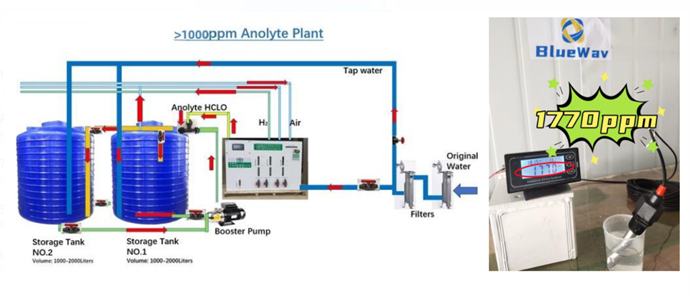The effect of hypochlorous acid on the bacterial biofilm on the surface of orthopedic internal fixation is mainly reflected in its strong oxidation. With the development of orthopaedic surgery technology and material science, metal internal fixation instruments are widely used in the surgery of fractures, bone defects, bone tumors, bone diseases, etc. Orthopaedic internal fixation treatment has the advantages of good fixation effect, early functional exercise, convenient nursing and so on. However, the incidence of orthopedic internal fixation infection is relatively common, and its treatment is a very difficult problem in clinic. These infections have a high recurrence rate and a long course of treatment, which may affect the surgical effect, increase the disability rate and fatality rate, prolong the hospital stay of patients, increase the cost of hospitalization, increase the pain of patients, and make patients forced to accept additional operations or even death and other adverse consequences. It has been reported that hypochlorous acid can act on bacterial biofilm on dental titanium alloy to eliminate the growth of bacterial biofilm. Currently, there are few clinical reports that hypochlorous acid is directly used for infection after orthopaedic internal fixation. According to the study of Liang Jinzheng et al., hypochlorous acid solution can effectively remove bacterial biofilm on orthopaedic internal fixation by soaking. The experimental results showed that the longer the soaking time, the better the disinfection effect of hypochlorous acid solution, long enough soaking time can degrade and destroy the biological structure of bacteria, so as to achieve the purpose of disinfection.
In addition, HCLO, as a strong oxidizing agent, can penetrate the bacterial cell membrane and enter the bacterial body, causing the bacterial protein oxidation leading to bacterial death. This mechanism makes hypochlorous acid excellent at killing a variety of microorganisms, including bacterial propagules, viruses, fungi, and the most resistant bacterial spores.
However, it is important to note that hypochlorous acid may be affected by organic matter, as free chlorine may react with natural organic matter to form trihalomethanes, which reduces its antibacterial activity against biofilms. Therefore, in practical applications, it is necessary to consider the impact of environmental factors on the disinfection effect of hypochlorous acid, and take corresponding measures to ensure the best disinfection effect.
In conclusion, hypochlorous acid has a significant ability to remove bacterial biofilms from the surface of orthopedic internal fixations, but its effect may be affected by environmental conditions, and further research and validation are needed to optimize the use method and improve the safety and effectiveness of clinical applications.
What is the comparative study of the effect of hypochlorous acid on bacterial biofilm clearance on the surface of orthopedic internal fixations at different concentrations?
This study mainly investigated the scavenging effect of hypochlorous acid solution on bacterial biofilms formed by Staphylococcus aureus and Pseudomonas aeruginosa when soaked and perfused in vitro. Studies have shown that prolonged soaking time or combined perfusion can enhance the clearance effect of hypochlorous acid on the internal fixation of bacterial biofilm.
Specifically, in the experiment, Staphylococcus aureus and Pseudomonas aeruginosa were implanted on the orthopedic plate internal fixator for 3 days to form bacterial biofilm, and then hypochlorous acid solution was soaked for different time and a mixed solution of 6 liter hypochlorous acid and normal saline was injected to observe the morphological changes of the bacterial biofilm and evaluate the removal effect of hypochlorous acid on the internal fixator bacterial biofilm. The results showed that hypochlorous acid soaking for a long time could degrade and destroy the bacterial biological structure on the internal fixator, so as to achieve the purpose of disinfection.
Figure 2 | Scavenging effect of hypochlorous acid on Staphylococcus aureus biofilms
*Reprinted on CNKI 2095-4344(2022)15-02367-05
In addition, studies have shown that the bacteria were completely killed at a 4:1 ratio of HOCl to bacterial fluid, which is similar to the efficacy of 1.3% NaOCl and 0.2% CHX with a 1:1 volume ratio for 30 seconds of treatment. This shows that hypochlorous acid has a significant bactericidal effect under certain concentration and action time.
Is the long-term use of hypochlorous acid potentially damaging or affecting the orthopedic internal fixation material itself?
In addition, although there is no direct evidence of the specific effects of HOCL on orthopedic internal fixation materials, but it can refer to the study of the effect of sodium hypochlorite on dentin. The study shows that the higher the concentration of sodium hypochlorite, the more significant the decrease in the microhardness of dentin, and will destroy the organic components of dentin, reduce its elastic modulus and bending strength. These results suggest that hypochlorous acid may cause similar damage to biological materials at high concentrations.
BLUEWAV has 20 years advanced professional sterilization technology, can customize hypochlorous acid/HOCL/Anolyte solution and equipment for different medical fields, and use the unique principle of electrolytic diaphragm technology to produce pure hypochlorous acid disinfectant, which can meet the extensive disinfection and sterilization use in medical, agriculture, industry, etc., with broad spectrum and high efficiency and extremely cost-effective.



